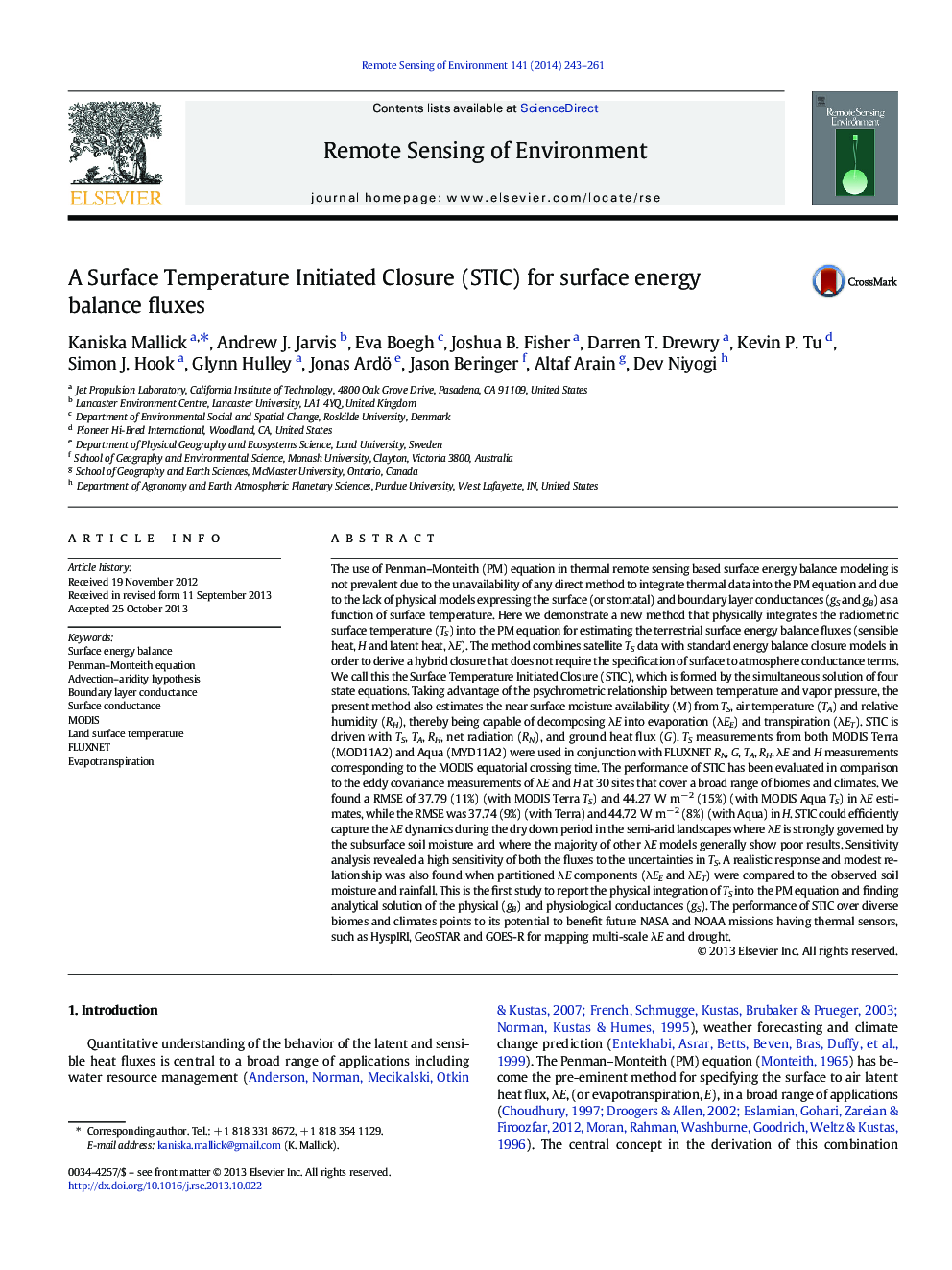| کد مقاله | کد نشریه | سال انتشار | مقاله انگلیسی | نسخه تمام متن |
|---|---|---|---|---|
| 6346847 | 1621259 | 2014 | 19 صفحه PDF | دانلود رایگان |

- Use of land surface temperature (TS) in Penman-Monteith (PM) equation is uncommon.
- Physical models are not available to express the conductances as a function of TS.
- Our method integrates TS into PM equation to estimate conductances and heat fluxes.
- Evaluation of fluxes revealed promising results over multiple biomes and climates.
- Evaporative fluxes behaved realistically with observed soil moisture and rainfall.
The use of Penman-Monteith (PM) equation in thermal remote sensing based surface energy balance modeling is not prevalent due to the unavailability of any direct method to integrate thermal data into the PM equation and due to the lack of physical models expressing the surface (or stomatal) and boundary layer conductances (gS and gB) as a function of surface temperature. Here we demonstrate a new method that physically integrates the radiometric surface temperature (TS) into the PM equation for estimating the terrestrial surface energy balance fluxes (sensible heat, H and latent heat, λE). The method combines satellite TS data with standard energy balance closure models in order to derive a hybrid closure that does not require the specification of surface to atmosphere conductance terms. We call this the Surface Temperature Initiated Closure (STIC), which is formed by the simultaneous solution of four state equations. Taking advantage of the psychrometric relationship between temperature and vapor pressure, the present method also estimates the near surface moisture availability (M) from TS, air temperature (TA) and relative humidity (RH), thereby being capable of decomposing λE into evaporation (λEE) and transpiration (λET). STIC is driven with TS, TA, RH, net radiation (RN), and ground heat flux (G). TS measurements from both MODIS Terra (MOD11A2) and Aqua (MYD11A2) were used in conjunction with FLUXNET RN, G, TA, RH, λE and H measurements corresponding to the MODIS equatorial crossing time. The performance of STIC has been evaluated in comparison to the eddy covariance measurements of λE and H at 30 sites that cover a broad range of biomes and climates. We found a RMSE of 37.79 (11%) (with MODIS Terra TS) and 44.27 W mâ 2 (15%) (with MODIS Aqua TS) in λE estimates, while the RMSE was 37.74 (9%) (with Terra) and 44.72 W mâ 2 (8%) (with Aqua) in H. STIC could efficiently capture the λE dynamics during the dry down period in the semi-arid landscapes where λE is strongly governed by the subsurface soil moisture and where the majority of other λE models generally show poor results. Sensitivity analysis revealed a high sensitivity of both the fluxes to the uncertainties in TS. A realistic response and modest relationship was also found when partitioned λE components (λEE and λET) were compared to the observed soil moisture and rainfall. This is the first study to report the physical integration of TS into the PM equation and finding analytical solution of the physical (gB) and physiological conductances (gS). The performance of STIC over diverse biomes and climates points to its potential to benefit future NASA and NOAA missions having thermal sensors, such as HyspIRI, GeoSTAR and GOES-R for mapping multi-scale λE and drought.
Journal: Remote Sensing of Environment - Volume 141, 5 February 2014, Pages 243-261